I’ve put together an easy-to-play-with online model of methane in the atmosphere. I’m going to use it for teaching along with the rest of the Understanding the Forecast webmodels, but it was designed to be relevant to the issue of abrupt new methane burps as we’ve been ruminating about lately on Realclimate.
The model runs in three stages: a pre-anthropogenic steady state which ends in the model year
-50, addition of a new chronic source for 50 years (from human activity),then a spike beginning at model year 0 (supposed to be today) and running for 100 years into the model future. Here are results from the “worst case scenario” in the last post (whether you believe it is the true worst case or not): 200 Gton C over 100 years.
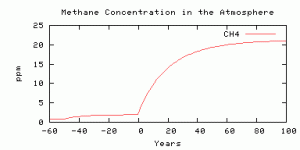
Looks like we got the factor of 10 methane increase about right.
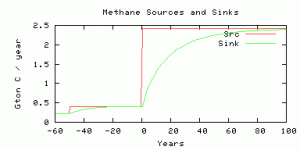
Source and sink of methane in the model.
The lifetime of methane in the atmosphere, used to calculate the methane sink in any time step, is parameterized as a function of concentration following Schmidt and Shindell (2003).
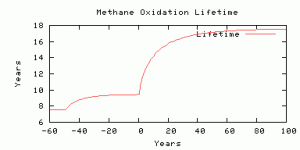
The atmospheric lifetime of methane, used to calculate the sink flux.
The radiative forcing is parameterized from output from the NCAR model, scaled by an efficacy factor of 1.4 from Hansen et al, (2005). The radiative forcing is compared with Business-as-usual CO2 radiative forcing with the model year 0 corresponding roughly to year 2010, and with CO2 rising at 0.65% per year. The methane radiative forcing before year 0 is not time-realistic because the real human sources did not switch on instantaneously 50 years ago, but you can compare the future evolution of radiative forcing from CO2 and methane, from year 0 onwards.
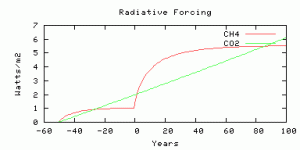
The radiative forcings of CO2 and methane compared. The scenario is more-or-less comparable to 750 ppm CO2, as we thought.
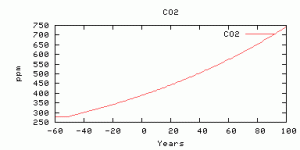
The CO2 concentration used to generate the last figure.
Timing is everything
Four simulations with the same amount of carbon released as methane in the “spike”, on different time scales for the release.
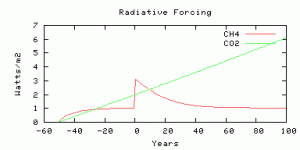
10 Gton C release in 1 year — the spike.
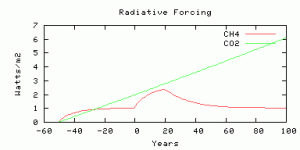
Same spike but not as sharp: 10 Gton over 20 years.
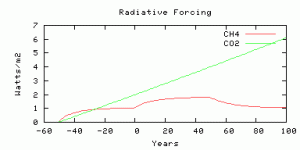
Same 10 Gton but spread over 50 years.
Enjoy. Go and get your swamp gas on, and give the poor model planet your worst. Bwahahahahaha!
References
- G.A. Schmidt, and D.T. Shindell, "Atmospheric composition, radiative forcing, and climate change as a consequence of a massive methane release from gas hydrates", Paleoceanography, vol. 18, 2003. http://dx.doi.org/10.1029/2002PA000757
- J. Hansen, M. Sato, R. Ruedy, L. Nazarenko, A. Lacis, G.A. Schmidt, G. Russell, I. Aleinov, M. Bauer, S. Bauer, N. Bell, B. Cairns, V. Canuto, M. Chandler, Y. Cheng, A. Del Genio, G. Faluvegi, E. Fleming, A. Friend, T. Hall, C. Jackman, M. Kelley, N. Kiang, D. Koch, J. Lean, J. Lerner, K. Lo, S. Menon, R. Miller, P. Minnis, T. Novakov, V. Oinas, J. Perlwitz, J. Perlwitz, D. Rind, A. Romanou, D. Shindell, P. Stone, S. Sun, N. Tausnev, D. Thresher, B. Wielicki, T. Wong, M. Yao, and S. Zhang, "Efficacy of climate forcings", Journal of Geophysical Research: Atmospheres, vol. 110, 2005. http://dx.doi.org/10.1029/2005JD005776
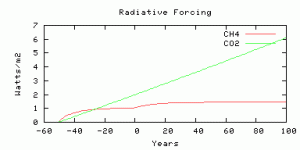
Re Hank Roberts (#97), not sure which other comments you mean, but thanks for clarification.
Though i have problems to understand what the differences is to “source” and “microbial processes”. I thought source is the hydrate, thus meaning methanogenesis is not trackable by 13C isotope.
> not sure which other comments you mean
That’s what I asked you to clarify.
You wrote above, criticizing the original post of the thread:
“new findings about carbon isotopes are not considered too.”
(Comment by prokaryotes — 15 Jan 2012 @ 5:21 PM)
What “new findings about carbon isotopes” do you know of?
Findings that “are not considered” in the model you’re criticizing?
“… new findings about carbon isotopes are not considered too.” (Comment by prokaryotes — 15 Jan 2012 @ 5:21 PM)
What “new findings about carbon isotopes” are you talking about? Do you know of any, or are you saying you believe there must be some in there somewhere?
I asked above and you quoted a paper consistent with the model — one of those I’d cited that support the model.
Do you know of any “new findings about carbon isotopes” that “are not considered” in this model?
RE Hank Roberts “What “new findings about carbon isotopes” are you talking about?”
It’s a bit strange you asking me again, since i answered you already in #92.
I’m not sure I understand the nature of the disagreement or confusion between Hank and prok here, but is this point from Manning (#111 in the “Much Ado…” thread) relevant?
“Chlorine seems responsible for removing about 5% of methane but it has a larger effect on the isotope ratios. References for more details are:
– Allan, W., Struthers, H., and Lowe, D.C., 2007: Methane carbon isotope effects caused by atomic chlorine in the marine boundary layer: Global model results compared with Southern Hemisphere measurements. J. Geophys. Res, 112, D04306, doi:10.1029/2006JD007369.
– Allan, W., Struthers, H., Lowe, D.C., and Mikaloff Fletcher, S.E., 2010: Modeling the effects of methane source changes on the seasonal cycles of methane mixing ratio and δ13C in Southern Hemisphere mid-latitudes. J. Geophys. Res, 115, doi:10.1029/2009JD012924.
– and another recent study showing that we might still need to know more about atmospheric chemistry relevant for methane removal in different places is at … Thornton, J.A., et al., 2010: A large atomic chlorine source inferred from mid-continental reactive nitrogen chemistry Nature, 464, 271-274.”
I don’t have time right now to track read over all these studies, but I’m guessing that Cl for whatever reason, reacts more with the heavy isotopes, so that methane coming from marine sources, even if they are fossil, look more like they are from more recent organic sources.
But I could be way off here (it wouldn’t be the first time). Just wanted to point to some studies that might be relevant to the discussion.
Prokaryotes, look again at the paper I referred to.
“CONCLUSIONS
We show here that there is little to no isotope fractionation when a gas hydrate either dissolves or dissociates. These results suggest than any measured changes in the isotopic values of environmental samples are a direct result of some other fractionation process, such as a different gas source or microbial processes.”
They’re supporting what’s been done — saying it’s possible to identify the source of environmental samples of methane based on the isotope ratio, confirming that ratio doesn’t get changed by some physical process that would the different sources hard to tell apart.
So the methane measured in the air has an isotope ratio that can be compared to the various possible sources.
That’s how the Point Barrow samples have been identified as from surface sources — the isotope ratios.
There are measurements of the isotope ratios for various sources. So far the methane from clathrates is dissolving, as in this description:
http://www.sciencedirect.com/science/article/pii/S0012821X99000928
If methane from clathrates were going into the atmosphere in a sudden rush, the ratios measured in the atmosphere would change.
This is the same way that carbon dioxide from fossil fuel is detected in the atmosphere, by the difference in the isotope ratios:
“Hans Suess relied on a variety of helpers to collect fragments of century-old trees from various corners of North America. He was looking for the carbon that human industry had been emitting by burning fossil fuels, in which all the carbon-14 had long since decayed away. Comparing the old wood with modern samples, he showed that the fossil carbon could be detected in the modern atmosphere.(5)” http://www.aip.org/history/climate/Radioc.htm
—
I’m sure one of the scientists here can explain this better. I’m trying to do it because the people who seem to believe clathrates have been bursting out don’t understand this method.
This is how scientists can detect a difference between gas from old clathrate deposits and gas from surface peat, vegetation, or microbial action.
Yes, Hank, and i replied to you in #101. Thanks again for a more detailed explanation about clathrate, hydrate, carbon isotopes and this study i cited.
Now as we have talked about carbon isotope, why not give some feedback to my main part of post #89 where i ask why David is not considering seabed methane?
@73: Thank you for the cite. I think it (and its reference to the “Arctic Palaeoclimate and its Extremes” conference) will be very helpful.
@78: That’s rather indefinite. @73 has given me some reading to flesh that out.
#89 Prokaryotes,
McGuire et al is an interesting paper, thanks for bringing it up. I suggest you read the section headed “Release of CH4 from hydrates in terrestrial and marine regions of the Arctic.” on page 22 of the pdf:
http://library.arcticportal.org/1216/1/McGuire-Arctic_C_Cycle_Review-EcologicalMonographs_2009-laser_reprint.pdf
In short the authors note that deep melting of gas hydrate is likely to be a millenial scale process, and that the erosion mechanism does not support the rapid release of a large amount of CH4.
So yes the figures you have taken from the AMAP do sound alarming. But that report does start the paragraph you have used by noting that the amount of CH4 that could be emitted is ‘theoretically’ enormous. Archer’s work, and work by other researchers such as McGuire et al suggests the problem from marine clathrates is more likely to be ‘chronic’ rather than ‘catastrophic’.
In short you have some reason to input large numbers for CH4 pulse into Dr Archer’s model, but you must also put large numbers into the model for duration of release.
As for new findings from C isotopes…
Fisher 2011 “Arctic methane sources: Isotopic evidence for atmospheric inputs.” find that the Carbon 13 in CH4 isotope signature suggests a role in the recent CH4 increase for wetland sources in the Arctic, and that the signature of marine hydrates is not detected. In closing they note that wetland CH4 has played a role in past interglacial warming, so can be supposed to be a likely player with ongoing climate change. But as I’ve already outlined to another poster here (post #73), even as recent as the early holocene evidence suggests the Arctic was warmer than now for a substantial period, and there was no methane cataclysm then.
To be clear: I’m not saying this is not a problem. I think we’ve probably already started the land permafrost carbon cycle feedback in the Arctic. But concluding that is a helluva way short of concluding some kind of catastrophic climate change due to massive rapid CH4 releases.
#95 Sidd,
According to Shakhova & Semiletov 2010 The East Siverian Shelf “is a shallow seaward extension of the Siberian tundra that was flooded during the Holocene transgression 7 to 15 thousand years ago (17, 18).” The sea-ice conditions implied by the research I cited suggests winter was not so cold as to be able to counter the substantial summer insolation increase.
Actually exposure to air and direct sunlight will cause far faster warming than if the ocean has to warm first to pass the warming on to sediments – i.e. land air temperatures are increasing faster than ocean air surface due to the higher specific heat capacity of water – it’s a damping effect.
Re 69 Ray,
This instant, I am not worried about clathrates, I am worried about free methane under a permafrost cap under the Arctic seas. These seas are shallow enough ( less than 100 meters) to be affected by changes in sea ice and mixing by storms. Loss of sea ice allows changes in wind driven ocean currents. Changes in sea ice formation change amount of cold rejected brine available to cool the sea bottoms. And water in currents from the North Atlantic is warmer than it was just a few years ago.
The voice of science is considered trustworthy when science always tells the truth and gets it accurate. Understating an effect or impact will cause as much loss of trust as overstating the situation.
Re 73
Before observations?
Are you talking 50 years ago? 500 years ago? 5,000 years ago?
I have a relevant (I think) question.
In the “enthalpy of fusion” article in wiki it gives the energy to melt water ice as 79.72 cal/g.
So it takes about 80 times more energy to melt a given mass of ice as it does to heat the same mass of water by one degree. (Am I right so far?)
So wouldn’t that mean that it takes the same amount of heat to melt a meter of ice as to heat 80 meters of water by one degree? (OK, a bit more than a meter of ice, or a bit less than 80 meters of water, since ice is lighter than water.)
But clearly more than a meter of ice has been melting in the Arctic in recent summers over much of the Ocean, so once that ice goes, doesn’t all that solar energy go into heating the water?
And besides reasons of phase shift, doesn’t the solar energy get absorbed much more efficiently by the open water than by the ice (albedo and all that)? So presumably then the heat needed to melt one meter of ice could heat much more than 80 meters of water?
If the heating mostly happens on the surface, doesn’t that mean that it is heated much more than one degree? But, as Lewis just pointed out, an ice free ocean is also a much more turbulent ocean, so mixing of any such super-heated surface water down to the bottom should happen fairly easily, especially in storms and high winds over relatively shallow waters.
ESAS averages 50 meters in depth, so in theory all of that could be heated by more than one degree with the same amount of energy it took to melt the overlaying meter or so of ice.
Am I missing something?
If not, why again shouldn’t we worry about things melting at the bottom of the ESAS in the context of that area being ice free for more and more of the summer?
(Sorry to pepper the questions. Just trying to get a handle on things.)
(reCaptcha Mrioduc data)
Aaron, again,though, the paleoclimate does not indicate an abrupt release, and if we didn’t see on in the early holocene, it is unlikely we are going to see one soon. Yes, it’s a concern. No, it isn’t he main issue…yet.
About submarine permafrost and the paper ask for more research into seabed methane deposits. I would have liked to quote more..
On carbon transport and fate in the East Siberian Arctic land–shelf–atmosphere system
Recently detected warmer water temperatures near the seabed may also impact the stability of the ESAS shelf’s submarine permafrost (Holemann et al 2011, Shakhova and Semiletov 2007, 2008).
Our measurements of CH4 taken in 1994–9 and 2003–10 over the ESAS demonstrate that the system is in a destabilization period (Semiletov 1999a, Shakhova et al 2010a, 2010b, 2010c). Moreover, unlike most other sub-sea locations where CH4 oxidizes within the water column, a substantial amount of CH4 released at the seafloor in the shallow ESAS is delivered to the atmosphere (Shakhova et al 2010b, 2010c).
We suggest that fluxes from the ESAS could contribute to rising atmospheric CH4 because the ESAS serves as a source of CH4, annually releasing ∼8 Tg CH4 to the atmosphere.
http://iopscience.iop.org/1748-9326/7/1/015201/pdf/1748-9326_7_1_015201.pdf
OK, they’ve got some measurements:
Figure 8, captioned: “Distribution of mixing ratios of CH4 in the atmospheric layer above the sea water (a) and concentrations of dissolved CH4 in the surface layer of shelf water (b) (September 2005).”
They refer to “taliks” — “Observations showed a highly mosaic pattern of dissolved CH4 spatial distribution in the shelf water…. determined by the current state of sub-sea permafrost, which has failed to seal ancient carbon pools sequestered in seabed deposits within and beneath permafrost, and which provides CH4 with migration pathways; among such pathways taliks could be considered to be primary.”
Look up “talik” and “pingo” for more on what that’s about; note that our idea of how a pingo forms — both on land and underwater — has changed lately.
They say they still need to distinguish old methane from recent methane as the area has a lot of river sediment full of decaying organic material — and for models incorporating that kind of data once they have it.
That makes sense. They aren’t building models based on assumptions, before the data is collected. That makes sense too.
Wili,
Light only penetrates a few meters into water, so any heat transfer below this level is due to transport of water. However, the deep water is both saltier and colder, therefore denser. If anything, warming once all the ice is gone will only increase stratification.
This is not without consequences–the bottom water is much more nutrient rich. However, loss of sea ice doesn’t necessarily mean that the bottom will heat up immediately.
Look up the limnic eruption reference I posted recently–I think that might be a possibility as a worst case.
#115, #117–And to complicate things further, I believe some work has attributed considerable amounts of sea ice loss to heat advected in from warmer waters, such as the Pacific. So you have to factor that in, too; it’s not just insolation.
Thanks, Ray. I had heard that heating of the surface can lead to greater stratification. Is that equally true for the very shallow waters we are talking about, waters that are more and more going to be agitated with larger and larger waves? And those waves could get much larger than what you can get in lakes, so I’m not sure the limnic article really applies here.
Shouldn’t the warmer waters also throw off a lot of evaporation, making it eventually saltier and denser…eventually heavy enough to sink through the colder water below? And doesn’t the new sea ice that forms every year now hold more salt, so when it does melt, it makes the surface saltier?
Maybe these processes are all to minor or slow to make a difference. Maybe not. In any case, for some reason, I’m still worried, long and short term about the stability of whatever is at the bottom of this vast, shallow expanse.
Happy MLK Day to all.
Very interesting.
I notice, however, that you are only tracking CO2 and methane.
According to Isaksen, we can expect on the indirect atmospheric chemistry effects to multiply the methane forcing by something like 250-400%, if global methane emissions increase by factors of 2.5 and 5.2 times, respectively.
Isaksen-Strong atmospheric chemistry feedback to climate warming
from Arctic methane emissions
Admittedly, these atmospheric chemistry effects are somewhat speculative, but they are based on a state of the art general atmospheric chemistry model.
I wonder what happens if you add Isaksen’s ozone, stratospheric water vapor, tropospheric hydroxly radical, and so on, into your model?
[Response:That’s supposed to be covered by Hansen’s “efficacy” factor of 1.4, which is included. David ]
My understanding is that every increase in forcing from any source would be amplified by the water vapor feedback, as temperatures increase.
[Response:Yes, but this is considered part of the response, rather than the primary forcing (as indicated by the radiative forcing). David]
Shouldn’t a true worst case scenario include atmospheric chemistry changes, and the water vapor feedback?
114 Ray –
“the paleoclimate does not indicate an abrupt release, and if we didn’t see one in the early holocene, it is unlikely we are going to see one soon. Yes, it’s a concern. No, it isn’t he main issue…yet.”
I’ve yet to see a justification for the comparison of arctic methane and anthro-CO2 outputs as significant threats – which appears to underlie both your comments and David’s three posts – yet we’d no doubt agree that their actual significance is in combination, not as notionally ‘alternative’ forcings.
From this perspective, while it is plain that ESAS has had millennia of slow natural warming since the holocene plus the radical anthropogenic warming of recent decades, and may thus be in an increasingly unstable condition, the possibility of a sudden massive outgassing seems of less concern than the high probability of a steady increase of ESAS CH4 outputs over the coming decades,
– in combination with rising CH4 & CO2 from both permafrost and from global peatlands hit by the northward retreat of increasing global rainfall;
– in combination with the dieback and combustion of global forest cover;
– in combination with cryosphere-decline and albedo loss;
– in combination with increasing water vapour.
Notably, the acceleration of the northward retreat of increasing global rainfall – as NCAR has depicted graphically – further compounds the acceleration of each of the terrestrial carbon-bank feedbacks plus the ESAS, while also advancing arctic albedo loss.
These and other mega-feedbacks must logically reflect the exponential rise of warming provided by our exponentially rising anthro CO2 outputs to date (David uses 0.65%/yr in his model ?) unless there is some mechanism whereby feedbacks can somehow convert an exponential driver into a linear output.
With these and other feedbacks now active due to the timelagged warming from the pollution of the mid-’70s, they will enjoy further warming, acceleration and interaction until about 2050 off our pollution output to date. They will also be driven by the intended loss of the ‘sulphate parasol’, which Hansen evaluates as being around a doubling of warming received. After 2050, they will be driven for further decades of acceleration (until ~2090 ?) both by their own interactions and by the long tail of timelagged warming from anthro-GHG outputs being phased out. It seems likely that warming will also be accelerated by the net decline of major carbon sinks.
I’d doubt anything I’ve written is new to you or to many others here, but I’m puzzled as to why this inexorably rising threat is not the focus of evaluation, rather than the dramatic but currently under-quantified ESAS prognoses. There seems no prospect whatsoever of even a radically fast phasing out of fossil fuels preventing the feedbacks having many decades of increasing warming, meaning that their outputs will, if they’re not controlled, easily exceed the carbon sinks’ capacity and thereby become self-fuelling.
Unless I’m missing some critical negative feedback or novel sink, it thus appears that the conventional policy-goal of ending anthro-GHG outputs is entirely necessary but evidently insufficient as a commensurate response to our predicament. With respect, I’d suggest that the sooner this question is acknowledged and addressed (preferably here on RC) and a demonstrably commensurate response agreed, the better our chances.
Regards,
Lewis Cleverdon
Lewis “I’ve yet to see a justification for the comparison of arctic methane and anthro-CO2 outputs..”
For example a 1 Gt comparison..
Image shows the impact of 1 Gt of methane, compared with annual fluxes of carbon dioxide based on the NOAA carbon tracker.
http://climateforce.net/2012/01/16/1-gt-of-methane-in-the-arctic-what-would-be-the-impact-of-such-a-release/
What if all the methane hydrates dissociate, and a trillion tons of methane end up in the atmosphere over a 100 year period?
After all, that is what positive feedback is all about, right? Increases in temperature caused by methane releases could of course stimulate additional methane releases.
In that case, your online model shows radiative forcing from methane at about 15 W/m2, methane lifetime goes up to close to 40 years, methane concentrations increase to 450 ppm or so, and so on.
CO2 concentration in your model does not change, though- you are showing business as usual CO2 concentration, even though methane is oxidized into CO2.
Methane concentrations at this point are about 450 ppm, though, so surely a couple hundred ppm of additional CO2 would be produced by this time, from oxidation of methane- on top of business as usual CO2. By the way, what about CO2 and methane produced from rotting permafrost?
Also, water vapor seems to be missing from your model. Wouldn’t the water vapor feedback multiply all the other greenhouse forcings, by several times?
Also, atmospheric chemistry effects of release of methane are missing from your model. I don’t see any ozone curves, for example.
[Response:Parameterized in the efficacy factor of 1.4. David]
I think, David, that you were hinting that this model represents a realistic real world model. But in several ways, your model tends to minimize realistic real world forcing if large amounts of methane are produced.
If we ever get 15 W/m2 of forcing from methane alone, is it truly inconceivable that we would get the additional 45 W/m2 needed to produce a true runaway climate from water vapor and other greenhouse gases? Wouldn’t the oceans start to boil, at some point?
[Response: Not before the sun turns into a red giant. – gavin]
A blog post with some recent data about Daisyworld, i posted this last week, but today i updated it with a new NASA video explaining Daisyworld model.
Ooops, the linkage http://climateforce.net/2012/01/13/the-daisyworld-model/
Hi Gavin-
I’m glad you’re sure of that. But that is of course a conclusion on your part.
Realistically, though, the jokers in the deck in all of this might be water vapor and atmospheric chemistry effects of methane.
The water vapor infrared absorption curve has lots of peaks in it… at high concentrations of water vapor, it could rise like a curtain, I think. And water vapor is the real 500 lb. gorilla of greenhouse gases, right? Does David’s model include water vapor, implictly, in some way that I am not aware of?
Realistic atmospheric chemistry effects of methane could, according to Isaksen (referenced above) multiply the greenhouse forcing of methane by several times. David’s model does take increased methane lifetime into account, but I don’t see any curves for ozone, hydroxyl radical, nitrous oxide, carbon soot from burning forests and peat beds, or of course, for water vapor. And I don’t see secondary CO2 produced from oxidation of methane in his model, at all.
I sometimes see arguments on this site that assume that if widespread dissociation of hydrates did not occur in warm periods in the past, they can’t occur now. But, with hydrates, might the truly most important variable be rate of change, not absolute temperature? Strong enough positive feedback would seem to make that possible, right?
I don’t see that in this model. Of course, this is a vastly simplified model. What is puzzling about it, though, is that it is simplified in ways that tend to unrealistically minimize the impact of large amounts of methane in the real world, while claiming to be a realistic teaching aid to model that same scenario.
Lewis,
First, we have not had a millennium of steady warming. Until the recent surge, conditions have varied–some periods cooler and others warmer. From 7-8000 years ago, we had a couple of 300 year periods with temperatures as high or higher than current temperatures. It is likely that most of the important feedbacks now were also extant then. For this reason, I think the prospect of catastrophic release is remote in the near term. That in no way means we are out of the woods.
Also, I believe that if methane increased to 450 ppmv as Leland suggests, we’d no longer be in the region where CH4’s warming potential exceeded that of CO2, and forcing would probably increase logarithmically in that range.
Leland Palmer ask “What if all the methane hydrates dissociate, and a trillion tons of methane end up in the atmosphere over a 100 year period?”
There is an estimate of 2-65 Gt of methane hydrate in the shallow of ESAS. I think it is a good start to model basic numbers like 1 Gt/ 10 Gt/ 20 Gt etc.
This is a higly chaotic “non-linear” system, which tends to react rapidly (decadal to century and millenia scales). And then there is the OC / POM flux with Organic Carbon, Particulate Organic Materials, originating from the thawing terrestrial permafrost, transported through the rivers there. Then does the weather situation correspond with the greenhouse gas uptakes, probably mostly from coastel erosion, which can be up to 80 meters a year.
I think it is quiet likely that by the end of the century, we have a worst case scenario and possible felt much earlier. So what do you do when you face such a scenario? Do you prepare liek Lovelock insist, and build Arks?
Or do you start large scale global actions, to suck carbon back and use for exampel biochar applications to help natural carbon sinks, emitting less? So far the natural carbon sinks, compensated most of the warming, but with the looming threat of large impact – inputs, the sinks will be overwhelmed.
It must be made more clear, that we need to preapre for abrupt episodes, already. The government needs to act and needs to shut down the denial machine. We need to reduce the greenhouse gases now, to give the natural carbon sinks now some buffer.
prokaryotes, what is your basis for concluding that the system is chaotic? Indeed, what is the basis for assuming its response is nonlinear?
In mathematics, a nonlinear system is one that does not satisfy the superposition principle, or one whose output is not directly proportional to its input http://en.wikipedia.org/wiki/Nonlinear_system
Mathematics A dynamical system that has a sensitive dependence on its initial conditions. http://www.thefreedictionary.com/chaotic
The hydrates accumulated over a longer time periode, but the release is rather abrupt. And the sensitivity, is dependent on temerature, which in turn depends on a wide range of factors. So i think that’s why i wrote that. Also the resulting impacts from large scale releases, are likely turn out chaotic.
prokaryotes, I am familiar with the definition of a nonlinear system as well as that of a chaotic system.
It sounds as if you are using them as synonyms for “complicated”. They are not. They are also often used as synonyms for “beyond all human understanding,” “beyond here there be dragons,” and “abandon hope, all ye who enter here.” This usage is also incorrect.
I see no evidence of nonlinear or chaotic behavior in methane emissions. If you do not have any ready at hand, I would recommend a less technical term such as “complex”.
“If you do not have any ready at hand, I would recommend a less technical term such as “complex”.”
Ok, ofc.
Prokaryotes,
I note that you just let my post #110 breeze past you without paying the blindest attention.
Ray asked you a very pertinent and succinct question in #129. Your reply #130 is evasive – 2 unrelated factoids followed by an unevidenced assertion:
“The hydrates accumulated over a longer time periode, but the release is rather abrupt.”
Above you seem to accept that millenial timescale releases is one outcome. However in that same post (#128) you drift back to form claiming “I think it is quiet likely that by the end of the century, we have a worst case scenario and possible felt much earlier.”
I think it is worth noting that your blog paints a rather more imminent picture (e.g. useage of preliminary CH4 data and selected AIRS images used to give the impression it’s starting now).
I’ve decided that this ‘discussion’ is a waste of my time.
“But, with hydrates, might the truly most important variable be rate of change, not absolute temperature? Strong enough positive feedback would seem to make that possible, right?”
What would the mechanism be? Most of the climate impacts that depend on rate-of-change are biological: animals can’t adapt fast enough. Most physical systems care more about absolute temperature than rate of change – there’s an equilibrium value based on the absolute temperature, and they will move in that direction faster or slower depending on the inertia of the system. The one exception that comes to mind is acidification, where we are overwhelming the ocean’s buffer system faster than carbonate can dissolve from the seafloor, so there’s potential for short-term aragonite saturation issues. But I don’t see this as a methane hydrate issue so much…
Chris R. “..used to give the impression it’s starting now”
If you see it this way, i don’t think that i state somewhere necessarily that it is beginning now. Also only because i link or quote something doesn’t necessarily reflect my own views, it rather helps me to get a better understanding and learning from the entire spectrum of knowledge about the topic at hand.
But what i think is that it “could” possibly have larger impacts on a time periode from decade to century to millenia scale. Which because of uncertanties necessitates, action today.
Leland Palmer,
Actually we don’t need to wait all the way for the red giant phase of the sun to generate a runaway or “moist greenhouse”, although we still need to wait at least another billion years or so for enough stellar energy to be deposited on the planet in order to sustain such a scenario (in the red giant stage it’s actually possible the Earth is engulfed completely by the expanding sun, although I believe the current consensus is that enough mass is lost from the sun such that the Earth would actually have a more distant orbit, which could allow it to escape from being engulfed).
What you’re missing is that water vapor dictates the slope of the outgoing radiation to space with respect to temperature, which increases climate sensitivity, but to determine if it gets into a runaway you have to also know where (or if) the OLR asymptotes to a unique value (i.e., when does the OLR become independent of the surface temperature). Whenever the surface temperature is below the critical point of water (647 K), the OLR cannot be too much higher than a certain threshold value, which numerous studies have pinpointed to be roughly 310 W/m2 or so. That value happens to be much higher than the current amount of sunlight the Earth gets, and is almost independent of the methane concentration, and so it will always reach a radiative equilibrium state (of course, the Earth could become 500 K and inhabitable but still not in a “runaway greenhouse” phase). In the runaway state, the temperature would be much higher than 647 K and well over 250 bars of atmospheric pressure, incompatible with liquid water.
The other thing lost in a lot of these catastrophe scenarios is that methane is not actually a great greenhouse gas. It’s not even as good as CO2, which absorbs energy right near the peak of emission for an Earthlike planet. The only way it makes sense to say methane is more powerful is when you compare incremental changes of a gas relative to two very different starting concentrations (since adding 1 ppm to a background of 1 ppm means a lot more than adding 1 ppm to a background of 400 ppm, since the effect of GHGs on the radiation budget eventually becomes logarithmic). But if you were to compare them fairly, like 100 ppm CO2 vs. 100 ppm CH4, the CO2 has a larger impact on climate.
Leland Palmer: “But, with hydrates, might the truly most important variable be rate of change, not absolute temperature? Strong enough positive feedback would seem to make that possible, right?”
Short answer: NO.
Longer answer: The only way I could see something like this happening is if you had a perturbation and a restorative force that could be overcome by a rapid enough impulse. That ain’t the system we’re looking at. So…NO.
> uncertanties necessitates, action today.
Nope. Throwing a mix of science, speculation, and catastrophism against the screen hoping something sticks doesn’t necessitate action.
Try tracking down who’s pushing the speculation and catastrophism and sorting out that -stuff- from the science — you can do that on your own blog instead of porting it all here to see what others say.
That would be a service to readers.
Hank Roberts, “you can do that on your own blog instead of porting it all here”
Can you be more specific what exactly you are talking about? You just conflicted me with someone else, in the other topic and one of the moderators does not let me reply to your claims.
[edit: dealing with your behavior is getting really irritating]
> if [in addition to our CO2] methane increased to 450 ppmv as Leland suggests, we’d no longer be in the region
prokaryotes:
go to your blog, at your home page.
You have links there to a variety of stuff.
I suggest you review who and what you link to.
Some of it is science.
Some of it is to a geo-engineering blogger with planetary-alignment-quake-methane-doom stuff.
It seems you want help telling the science from the stuff.
If so, you could invite readers to come to your blog and comment.
If you’re associated with Climate Progress, their readers could help too.
Or ignore me. I’m just some guy on a blog.
If you want attention, make it worth the readers’ time.
“Leland Palmer: “But, with hydrates, might the truly most important variable be rate of change, not absolute temperature? Strong enough positive feedback would seem to make that possible, right?”
Short answer: NO.
Longer answer: The only way I could see something like this happening is if you had a perturbation and a restorative force that could be overcome by a rapid enough impulse. That ain’t the system we’re looking at. So…NO.
Comment by Ray Ladbury — 18 Jan 2012 @ 3:33 PM”
Ray,
This quote doesn’t exactly refute your assertion, but it does in that it notes the change in the relationship between temperature and pressure, and that would definitely be affected by, and affected by, rate of change:
“What destabilizes clathrates is not so much the absolute temperature as the shift in the pressure-temperature conditions.”
That is from V. Petrenko. ironically, he was arguing I was wrong about the clathrates detabilizing faster than expected. His argument was the rapid change at the end of the Younger Dryas didn’t trigger massive release. My argument was that the world was bleeping cold already and warmed rapidly, but still to a sub-frozen temp wrt the clathrates, thus it’s no surprise they didn’t destabilize.
This exchange happened in April 2009.
The warming since then from continued inundation, runoff, etc., and all that accelerated warming of the Arctic sea bed – if I recall information at that time was that clathrates were up to – 1.8C, which is very close to the melting point. There has certainly been warming since then. And remember we are talking about clathrates not deep under the ocean, but @ 50m. The pressure is very low compared to deeper clathrates so the temperature change must be more important in the balance than for deeper clathrates.
Anyone taking this issue even a little lightly, assuming we have centuries before they could possibly blow, is, imo, in for a very serious surprise. I will maintain my position that research over the next few years will bring only worse and worse news about clathrates and permafrost and add that a warming signal from Arctic Methane will begin to be measured. The idea of emissions big enough and in a short enough time to significantly affect warming in my lifetime – I’m in my mid-40s – will become a serious consideration to the degree it is considered generally likely.
If the sea ice melts out (80% gone-ish) in ht next 3 – 5 years, I guarantee the above.
The Dec satellite image is up for Arctic atmospheric methane (at 400 mb) and it shows the darkest splotch of deep red (high methane concentration) over the ESAS (as well as over southern Siberia) that I have seen for December.
It may or may not be the large blowout that some of us feared, but there is definitely something unusual going on with Arctic methane this year.
ftp://asl.umbc.edu/pub/yurganov/methane/MAPS/NH/ARCTpolar2011.12._AIRS_CH4_400.jpg
(And compare with December of last year–or any previous year you care to check:
ftp://asl.umbc.edu/pub/yurganov/methane/MAPS/NH/ARCTpolar2010.12._AIRS_CH4_400.jpg )
The satellite image for Arctic atmospheric methane for December is out and it shows the strongest concentration of methane over ESAS from any of their monthly images back as far as they go.
ftp://asl.umbc.edu/pub/yurganov/methane/MAPS/NH/ARCTpolar2011.12._AIRS_CH4_400.jpg
Something unusual certainly seems to be going on with Arctic methane this year.
Hi Chris-
David’s model is an incomplete model. It is incomplete in several ways, and each way that it is incomplete underestimates the true known impact of large releases of methane. It’s great that he put it on the web, but it needs work, I think.
One basic way David’s model is incomplete is that as the methane oxidizes, it converts to CO2. So, it should not be too hard to simply add that CO2, at each step, into the business as usual CO2 projections.
[Response: This is trivial (and is done in the Schmidt and Shindell code) – but note that for 2000 ppb CH4 is only 2ppm, and gives rise to 2ppm increase in CO2 – a number that is much smaller than the impacts of direct CO2 emissions and their uncertainty. – gavin]
Another basic way David’s model is incomplete is that it does not include water vapor. The Clausius-Claperyon relationship gives approximate water vapor concentrations at each temperature. So, he needs to add the water vapor feedback into his model, in some way. Since these are back of the envelope calculations, just use the C-C relationship.
[Response: This is part of the climate sensitivity, and is already incorporated. – gavin]
Each greenhouse gas acts logarithmically- except perhaps for the atmospheric chemistry effects of methane. Methane of course degrades concentrations of the hydroxyl radical, and so large releases of methane catalyze their own increase in atmospheric lifetime. David’s model does include that, but does not include tropospheric ozone, stratospheric water vapor produced by methane, stratospheric hydroxyl radical, or secondary CO2 produced by oxidation of methane. Isaksen says that these could multiply the greenhouse effects of methane itself by several times, especially for very large releases of methane.
[Response: Yes it does. The 1.4 factor (to get the effective forcing) incorporates these indirect aspects of methane. – gavin]
David also needs to include known effects of warming on permafrost, in his back of the envelope model. It doesn’t have to be fancy, but it does need to be included in any model that he hints constitutes a worst case scenario.
[Response: That is where the methane is hypothesised to come from – so this is the input! – gavin]
No single greenhouse gas could lead to a true runaway scenario- that seems clear. Methane and CO2 together also cannot lead to a true runaway scenario, very likely. But can CO2, methane, atmospheric chemistry effects of methane, water vapor, nitrous oxide, the albedo changes, and rotting permafrost lead to a true runaway scenario?
Show me.
Fix the model, and include all known major factors. What I’m asking for is a back of the envelope model which realistically includes all known major factors.
wili, you’re looking at a picture from the AIRS instrument.
Yes, it has more red on it than some others.
You then tell us based on that
“Something unusual certainly seems to be going on with Arctic methane this year.”
Why? Behind the picture is — what, exactly?
Find the FAQs and the invitations to ask questions at the AIRS sites — there are several.
Most sites that post science imagery try to explain what the pictures mean and how to get the underlying data.
For more details on CH4 fluctuations see the Dr. Natalia Shakhova interview & comments at Skeptical Science.
144 Gavin wrote: “[Response: This is part of the climate sensitivity, and is already incorporated. – gavin]”
David wrote in the margin of my comment 34:
[Response:Water vapor feedback (warming leads to more water vapor leads to more warming) is considered a part of the climate response, not part of the radiative forcing, by definition. The source of water in the stratosphere from the hydrogens that methane carries is part of the “efficacy” of the methane forcing, a factor of 1.4 from Hansen, which is included in the on-line model. David]
My reading of David’s comment was that the model does not contain water vapor feedback because it doesn’t output climate sensitivity or climate response. The model output is “radiative forcing” plus methane concentrations, lifetime, what the sources and sinks are doing, etc.
Hi Gavin-
Yes, unless the first large releases of methane end up creating further releases, as tipping points are passed. In that case, with a trillion tons of methane release over a hundred years, we get 450 ppm of methane, and the CO2 produced from that is not trivial, at all.
Are you sure?
You guys get the 1.4 figure from Hansen?
You’re sure that he includes the sort of atmospheric chemistry effects that Isaksen does? I know that atmospheric chemistry effects from methane release have been postulated in the past, but the magnitude and severity of the atmospheric chemistry effects seemed to me to be a new result.
You’ve read the Isaksen paper?
A quick question, with CH4 approximate half the density of air, is any lost to space by solar wind ablation, or does our magnetic field help to hang onto it for complete eventual oxidation?
If there are some losses, then perhaps it could improve our optimism.
[Response:Methane carries hydrogen into the upper atmosphere where some of the hydrogen can be lost to space. Lovelock called methane Gaia’s hydrogen balloons, performing the function of oxidizing the planet. But he’s just funny. David]